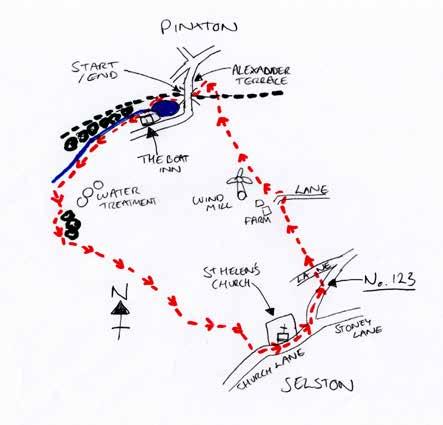SELSTON,





12 EDITIONS READ BY OVER 162,000 RESIDENTS




SELSTON,





12 EDITIONS READ BY OVER 162,000 RESIDENTS



Ah, Mother’s Day – or as it was more traditionally known, Mothering Sunday, the one day of the year we are all supposed to thank the women who gave life to us and the ones who raised us (they aren’t always the same people).
But did you know that the UK Mothering Sunday probably has very little to do with honouring our birth mums and carers?
Although the facts are murky (thanks Wikipedia for all the conflicting accounts!) it appears that the day is connected more closely to Christianity than to showing our mum how much we love her.
You see, in the UK, Mothering Sunday is not a fixed day as it is in the US, instead it is linked to Lent, the Christian period of abstinence preceding Easter. And as we all know, Easter, and therefore Lent, is a moveable feast (or nonfeast in the case of Lent!). Mothering Sunday always falls on the fourth Sunday in Lent (Laetare Sunday), three weeks before Easter Sunday – this year, that means March 10th.
If you try to search the history of Mothering Sunday, you will find claims it was initially linked to The Feast of Annunciation, a day devised to celebrate the Virgin Mary – Mother Mary, and held each year on March 25th. I read, “it is no coincidence that over time, March 25th, or the nearest Sunday, became a celebration of all motherhood.”
I’m not altogether sure I believe this…
The alternative view is that by the 16th century people were moving away from the areas in which they had been born, and therefore
baptised, but would return once a year around Lent to visit their “Mother Church”.
Another tradition dating back to the same time is those working in the fields, farms, and grand houses of wealthy landowners would be given the day off on the fourth Sunday of Lent to visit their mothers and possibly go to church. With no cars, buses, or railways, that may have been a difficult task, and it certainly marked a move towards the more family focused Mother’s Day we celebrate today.
Whatever the origins, Mother’s Day should not be the only day we give extra love and attention to all the mothers in our lives. I would rather see my grown-up children regularly bearing no gifts than have them turn up once a year with a bunch of flowers and a box of chocolates! The hype surrounding this one day helps those who don’t really care about family tick a box on their social conscience calendar…”card and flowers for mum” – tick.
Buy a card, make a card (us mums will always remember the ones made by little hands at school more than the ostentatious shop bought ones), give flowers, give chocolate and cakes…but most of all, give love and thanks to the person who carried you inside them for nine long months…and don’t just do that once a year!











Although Reverend Coke was the Rector of both Pinxton and South Normanton Parishes for forty years, he only officiated at a handful of formal ceremonies; baptisms, marriages and burials. Strange and unusual!
Reverend Coke was the man who has most influenced the village of Pinxton. Born in 1747 he was orphaned following the death of both his mother and then his father in the space of two years. From the age of ten, he was raised by bachelor Robert Lillyman and his sister Sarah, of Brookhill Hall. Following the death of Robert Lillyman in 1765, young D’ Ewes went to Cambridge University and studied theology.
According to the official history of The Cokes of Trusley, Sarah Lillyman, the beneficiary of her brother’s vast wealth and estates in Derbyshire, Nottinghamshire and Cheshire, had taken in instant dislike to his new wife; judging her to have been spoiled by her widowed father. Following a day hunting with Tristram Revell on the Camfield Estate, Rev. Coke was persuaded by his wife to take the pheasants he had caught to Miss Lillyman at Brookhill Hall. This resulted in an invite to dinner at which Sarah Lillyman’s opinion of Hannah changed.
When Sarah died in November 1780, she left all her wealth to Reverend Coke, who instantly became a latterday multimillionaire. This set him on the trail to re-purchase the coal mining rights under Pinxton, which his grandfather had sold. This resulted, in 1787, going into partnership with two experienced local brothers with mining experience. This resulted in the sinking of Pinxton’s first deep mine shaft in 1787. Mining operations
in the area to the West of the village had long been stopped as the coal workings quickly became waterlogged. Further mining was not possible unless the water could be pumped out of the coal workings. This could only be achieved by continuous pumping. This was at the cutting edge of technology. The reciprocal steam engine was perfected by Boulton and Watt in 1769 but required perfecting. How was it that such an engine was in operation in Pinxton at this early date?
Rev. Coke joined the newly established Derby Philosophical Society by Dr Erasmus Darwin (grandfather to the more famous Charles Darwin, author of ‘The Origin of the Species’). Dr Darwin was the physician of Watt’s son and regularly visited his Derby home where the DPS meetings were held. His partner, Matthew Boulton WAS a member of the DPS. This cannot have been a co-incidence that put Pinxton at the cutting edge of technology. In the following year Coke sank another deeper coal mine. A further steam engine was installed in 1795 at the Pinxton porcelain factory for mixed the paste.
There certainly more to Reverend Coke than has previously been revealed. He was involved in securing the Pinxton Mill arm of the Cromford Canal - a one-man quest.
The last record on him appearing in public was in December 1788 at
a meeting at Alfreton when it was agreed to proceed with the canal. WHY?
We do, however, have a cryptic note of July 1795 in his notebook; ‘Billingsley on about the china business’. Rev. Coke spent the last decade or so of his life, at Bath, where he died in 1811.
We get an indication of his demise in a note by his son John in the official history of the Cokes:
‘My father’s guardian ... having been bred to the Law acquired a degree of confidence and boldness... Which joined with a strong intellect, a stern temper, and an authoritative manner caused him to be much respected... My father, from his own account was harshly treated under the roof of his guardian’.
Was this a reference to a further comment from the Official History of the Cokes?
It also states, ‘... he had lost his sight, first injured (in his youth) by etching copper...’ and (his) ‘sense of hearing was dull in consequence to a blow on the head given him.’
The answer as to why he did not administrate at formal Church services is because an exact form of words are necessary. Difficult if you cannot see the words!
NEXT TIME Reverend Coke’s part in the establishment of the Pinxton Porcelain Factory.







✽ 2 spacious en-suite bedrooms
✽ A fully enclosed garden
✽ 2 small to medium dogs welcome (3 upon request)
✽ Fully equipped kitchen, including an American style fridge freezer


✽ Perfect for exploring the stunning Northumbrian Heritage Coastline
✽ Close to a range of dog friendly pubs, cafes and restaurants in stunning Warkworth
✽ We have fast fibre Wi-Fi and smart TV’s


Treat yourself to a luxury break at the 4* Gold Award winning Little Red Hen House. An elegant and cosy holiday home just a 7 minute drive from award-winning and dog-friendly Warkworth beach. www.coquetcottages.co.uk

















One of life’s great pleasures is a simple slice of toast – warm and buttery with a smell that instantly comforts you. In my childhood, a brass toasting fork hung on a hook at the side of the fireplace at our house and at that of my grandparents. Not for everyday use, but for special Sunday afternoons during the darker months when sliced bread, crumpets or pikelets would be skewered on the fork and held in front of a coal fire until golden and hot. The toast could be quite singed and tasted of coal smoke but that added to the sense of adventure. It would be enjoyed, not at the table, but around the fire with children and grown-ups waiting and hoping for the next slice to be theirs. Toppings were simple. Either dripping with salt, Bovril or proper butter (not axle grease, as my dad called margarine). What a treat.
One of our recent visits to a group has resulted in a lady generously donating a boxful of precious family items that she knew would be enjoyed by our many audiences. This box included a beautiful electric toaster that her parents had been
given as a wedding gift in 1952. It has flaps that open out for two rounds of bread. Very stylish and functional.

No one I knew had a toaster until the 1970s when teasmades also made a brief appearance. Usually, my mum would cook toast in the grill on the gas cooker. If you remember, the grill used to be at eye level, so you could keep an eye on what was toasting or burning.
Happy Days!














In the stampede to find the sunshine, how many of us neglect the country where we live when booking a holiday?
Yes, it is always nice to have those flat on our backs soaking up the sun kind of breaks (although our skin may not thank us for this later in life), but it is just as good for the soul to do something more meaningful in our downtime.
And that’s where holidaying in the UK, and in the case of this article, specifically in England, comes to the fore. With no flights, there’s no need to drive to an airport, pay exorbitant car parking fees, and not forgetting the minimum two-hour check-in; from our part of the world, it is possible to reach every corner of England within a few hours’ drive. And no overspending in dutyfree either.
If you’re not a driver yourself, plenty of coach operators offer tours and travel-only options to locations in England.
With such a rich and varied history in this country, not to mention the stunning scenery, we really should all take some time to explore England – starting with what is right on our doorsteps! I live in a chocolate box village (Foolow) in a beautiful part of the Peak District, and yet I regret to say I just don’t travel around enough. Some of that is because I am still working and being self-employed, I don’t always take the time out for holidays! But some is because I have become so used to living in a beautiful part of the country that I don’t always appreciate it.
Aiming to educate all of us about the wonders around every corner is the organisation, “Visit Britain”, which focuses on tourism in England from 15th to 24th March. Check their website https://www. visitbritain.org/working-us/english-tourismweek and subscribe to the newsletter to find out more.
In the meantime, here are some facts that may surprise you:
England’s tourism sector:
• contributes £106 billion to the British economy
• supports 2.6 million jobs
• is a major employer of school leavers and young people
• In 2019, British residents spent £19.5 billion on 99.1 million domestic overnight trips in England.
• 1.4 billion domestic day trips were taken to English destinations in 2018, with spending totalling £56.5 billion.
• There are estimated to be 5,000 to 6,000 visitor attractions in England. Why not make a promise to yourself to spend some time exploring your local area this year? Maybe book a few short breaks so you can see other parts of the country too. True, the sun may not always shine, but you’ll always be able to get a good cup of tea – well, unless you end up in one of those places with horrid, hard, scummy water!













Method:
1. Preheat your oven to 200°C/ fan 180°C/gas 6.
2. Put the vinegar, paprika, garlic, Worcestershire sauce and chopped tomatoes in a large, shallow, flameproof casserole dish. Put it over a medium-high heat, bring to a simmer and cook for 20 minutes, stirring occasionally. Season to taste.
3. At the same time, gently bash the bacon medallions to flatten them out and lengthen slightly. Stretch a piece of bacon over each chicken breast.
This pub grub classic has the slimming World twist, which means it is super healthy, filling and bang on plan.
Enjoy!
4. Nestle the chicken breasts into the sauce and spoon a little sauce over the top. Divide the mozzarella over the chicken breasts and bake in the oven for 20 minutes, or until the chicken is cooked through.
5. When the chicken’s almost ready, steam or boil the green beans for 3-4 minutes, then drain. Scatter the parsley over the chicken, then divide the chicken and sauce between 4 plates, and serve with the beans and baked potatoes.
For more information visit www.slimmingworld.co.uk
• 1½ tbsp red wine vinegar
• 1½ tsp sweet or hot smoked paprika
• 1½ tsp garlic granules
• 2 tbsp Worcestershire sauce
• 2 x 400g cans chopped tomatoes
• 4 smoked bacon medallions, visible fat removed
• 4 skinless and boneless chicken breasts
• 200g grated mozzarella
• 400g green beans, trimmed
• ½ small pack fresh parsley, chopped, to serve
• 4 microwaved or oven-cooked baking potatoes, to serve
Serves: 4 Ready in: 50 minutes


Vertical Blinds
Roller Blinds Roman Blinds


Syns per serving: 6





























This month the woeful weather left me wondering if dogs could suffer from trench foot. So, we pulled a short but sweet walk out of the bag. Despite this Flake still looked like some sort of bog creature by the time we got him back to the car. So it was straight into the bath when we got home.
The walk begins at Pinxton Wharf from where we head along the canal for a short while before branching off across country towards Selston. We enter Selston briefly and walk past St Helen’s Church. Before heading back across country back towards Pinxton Wharf.
Fingers crossed for better weather in March!

A gentle walk which should take you and your dog around 1½-2 hours to complete. There is a couple of quiet roads so please take care, however most of the walk is on paths and trails. Please wear appropriate footwear and, as always, follow the countryside code..

START: PINXTON WHARF, ALEXANDER TERRACE, OFF WHARF ROAD, PINXTON. NOTTS. NG16 6PL
1. Enter the wharf through a squeeze gate on Alexander Terrace near the railway crossing and continue straight ahead along the footpath directly in front of you. (Pinxton Wharf was the terminus for the Cromford canal, which was built to link the collieries to the River Trent. Pinxton China works were also in operation very close
to the wharf.) After some distance cross over a small wooden footbridge and then a little further on pass over a larger wooden footbridge. Immediately after crossing the 2nd bridge turn right to continue along a footpath with a canal on your right.
2. Continue along the footpath passing ‘The Boat Inn’ on your left, until reaching a squeeze gate. Pass through the gate and then bear right. After a very short distance pass through a gap adjacent to a large metal gate and continue straight ahead along a lane keeping the canal on your right.
3. Continue along the lane for some distance and the immediately after passing some sheds on your left, turn left to pass through a gap in a fence along a marked footpath. The path leads to a farm track. Continue along the track to continue up and over a bridge. Shortly after the bridge and just prior to reaching a large metal gate directly in front of you, turn left to walk along a farm track going uphill.
4. At the top of the hill keep ahead into an open field, passing a yellow marker post on your left. Continue straight ahead over the brow of the hill and down the other side aiming for a small single tree in the hedge row on the far side of the field. Cross over a tiny stream and pass through the hedge to continue straight ahead for a short distance across another field.
5. 5At the far side pass through a gap into another field and now continue with the hedge on your right. Upon reaching a large metal gate on your right, ignore a marked path straight ahead and bear left to continue along the edge of the same field keeping the hedge on your right. At the far side of the field continue straight ahead along a narrow path with a fence on your left until reaching a kissing gate. Cross the stile and continue along the edge of another field with a hedge on your right.
6. At the far side of this field pass through another kissing gate and then continue uphill to a road. Turn left along the road and after a short distance pass the church on your left. (Take a look at St Helens Church which holds the grave of Gypsy King Dan Boswell. [walk to the left hand side of the church and it is a few feet from the door by a small holly tree] The grave stone faces the wrong way-it is not the original stone which was supposedly broken in two after being kicked by a cow. This dates back to when cows were kept in
the church yard. St Helens Church also contains the only 12thC incised stone in England. This is sited by the Chancel and is really worth viewing.) After passing the church continue along the road for some distance until reaching No.123. Turn left along a marked footpath adjacent to No.123 going downhill. After a short distance cross straight over a lane, pass through a gap and continue straight ahead across a field with a hedge on your left.
7. Continue to the far side of the field, pass through a gap and continue through a kissing gate. Now continue with a hedge on your left. After some distance follow the path over to the right to meet up with a kissing gate at the far side of the field. Pass through the gate and cross over a tarmac lane onto a marked footpath. Pass a farm and then a wind turbine on your left to continue straight ahead going downhill with a hedge on your left.
8. At the bottom of the field keep ahead along a narrow footpath going downhill. At the bottom cross over a railway line and then continue for a short distance to pass through a squeeze gate. Immediately after, turn left pass through another squeeze gate to continue along a footpath. Continue until reaching a road and the start of your walk.




This walk is for illustrative purposes only. Voice Magazines Ltd takes no responsibility for anyone who chooses to follow this route and encourages all walkers to obey all byelaws and signs and to respect the area they are walking in, ensuring they pick up all dog mess and obey the countryside code at all times.

































Last September, I was walking back into Derby city centre after watching a dull goalless draw between the Rams and Cambridge United. It had not been a good afternoon.
As hundreds of disgruntled Derby supporters spread across the pavement, trudging along Chequers Road, it was difficult for me to pass. I was in a bit of a hurry – Mrs Musings had promised me a treat if I was home by 6pm – and was having to constantly jump out into the road to get past.
I’m not daft, I know my Green Cross Code and stuff like that and of course, I only did this when I couldn’t hear any cars approaching.
Unfortunately, I jumped once too often and was hit at speed, by something and after an initial feeling of excruciating pain, I simply blacked out. As I came round, I was surrounded by a sea of legs. These belonged to the many, no doubt very slow-moving people, who had seen what had happened and were concerned.
In the background, I could hear “I don’t know duck, he’s unconscious. Wait a minute, he’s just sat up. I’ll ask him.”
A bloke then stuck his face right up close to me and asked, “How old are you sir?” Rather petulantly I asked why he needed to know that. Well, to cut a long story short, he’d contacted the DRI. “You speak to them,” he suggested, and consequently, I assured whoever was on the other end, that I was fine and there was no need for an ambulance.
Not quite true of course, but as my injuries were not life threatening, I assured the poor chap who had hit me – he’d been on an electric bike – and who might have initially thought that he’d killed me, that it wasn’t his fault. After telling all those who had stopped to help that I’d be fine, I continued my route march (well, it was more of a limping hobble) back into town and even then, I was still overtaking punters on the way.
I recognise that I was very lucky, and family and friends have since given me lots of advice. Probably, the most surreal came from my Nottingham Forest supporting mate called Clive, who simply said “Well Mike. I’ve always told you that going to Derby and particularly Pride Park, should be positively discouraged. It’s not good for your health!”
Surviving this incident got me to thinking of what legislation could be introduced to prevent it happening again, to me or anyone else. OK, it may be controversial and certainly inconvenient for some, but I’d introduce a Bill making it a requirement that people who are unable to walk at a very reasonable 4mph, be banned from using pavements. Now, this is the first of a number of policies to be introduced were I to become Prime Minister. In the coming months, you’ll read of more. Meanwhile, at mike.musings@outlook.com, I’ll happily receive similarly bizarre suggestions from frustrated readers of Voice Magazine.























The Grace Year by Kim Liggett is a fast and furious read. It’s a mix of The Hunger Games, The Handmaid’s Tale and a female Lord of the Flies set in a dystopian society where girls and woman are believed to have “magic” which they use to control men’s minds and which has to be driven out of them in a Grace Year when they are 16. The best that can be hoped for in this misogynistic patriarchal society is to become a wife. Enter the rebel, Tierney James, brought up by her father to be
the son he never had and consequently taught a lot of useful stuff.
These girls aren’t sent to a nunnery to drive out their magic – they get an island where they have to survive against brutal odds. The ones that come back are the lucky ones – or are they?
It’s entertaining and a page turner – the sort of thing you could polish off quite happily on a cross country train journey. It’s not high literature, but it does grab your attention.




































Across
1 Massive mammals in the sad West Country, say? (4,6)
5 Stressed when the chimp ate the recipe (8)
15 Could be up to luck? “Seat belts on!” (6,2)
18 The canning process that could be captivating? (10)



Pitcherwits® are crossword puzzles where some of the clues are in pictures. Sound easy? It’s not called “Pit-your-wits” for nothing! The mixture of cryptic and picture clues, combined with Professor Rebus’ unique sense of humour, will keep you entertained for hours. These puzzles
Across
9 Cliff, like Craig, is a one-off (4)
10 Stinging insect, initially for a privileged group (4)
11 Heart bypass for Mother, perhaps? (5)
12 Tries out isotherms for resistance (4)
14 Squint, say, at marine platform (4)
Down
3 Made a bit of a hash of it with fiery leftovers (3)
4 Needs kicking out of the resort (3)
6 Salary increase that’s easy to rip out? (3,4)
7 Late application for a bit of a meal (3)
13 River coming up as far as one’s coat (3)
16 Bit too obtuse for employment (3)
17 Scaley bit in Oklahoma? (3)
Down
1 Search for treasure in sandy hairpiece? (9)
2 Sad songs that say so much about a leg, I see? (7)
8 Put caring in jeopardy by taking prisoner (9)



10 Racer that’s going to the dogs! (7)

Down: 1 Not a sausage, 2 Agent, 3 Lists, 4 Minor detail, 5 Begonia, 6 Popeyed, 10 Rural, 11 Truss.
Across: 1 Netball team, 5 Brews up, 7 Sight, 8 Super, 9 Ulnar, 11 Thyme, 12 Aground, 13 Edible snail.
ANSWERS FOR LAST MONTHS PITHERWITS




















Four Winds Landscaping

GROUNDS MAINTANENCE:
• Lawn Mowing • Cutting Banks • Edging & Strimming • Lawn Care • Bed Planting • Weed Control • Tree Surgery • Stump Removal • Hedge Cutting, Reduction & Removal •
LANDSCAPING:
• Driveways • Patios • Pathways • Fencing • Sleeper Beds • Turfing • Planting • Ponds



For more info T: 07506 797 978 or E: info@fourwindslandscaping.co.uk


Houseplants deserve a bit of TLC after being in centrally heated rooms over the winter so this is the time to replant any which are looking a bit droopy. Give them a slightly bigger pot and fresh compost and remove any dead foliage.
Summer flowering bulbs such as gladioli, alliums, acidanthera, lilies can go in now. They enjoy warm sunny spots either direct into the soil or, if you’re putting them in containers, in a mix of two parts compost to one part grit to give plenty of drainage. Feed them with a high potassium feed about a week after the shoots appear then regularly up till flowering.
Watch out for slugs – they like eating the green shoots of growing things almost as much as gardeners like seeing them and if your garden is particularly prone to slugs, it may even be worth giving the likes of hostas a miss altogether. Otherwise, make sure there’s no left-over leaves from last season on your soil, slugs love sheltering under them. You can try the old favourite traps, half citrus such as orange scooped out and filled with beer. The slugs go in for the beer and goodnight Vienna – at least in theory. Or you can buy nematodes, - a biological deterrent which you water into the soil – from garden centres or online. Some people use bark, others wool, others copper around the rims of pots. Worth trying anything once! And good luck.
You can mow your lawn now if you get a dryish patch of weather. But don’t bother unless it’s actually growing – and that depends on the temperature – and the fact that it will be visibly longer!


A huge influx of waxwings has caused a big stir amongst birdwatchers and other visitors. The birds have been arriving across northern England from Europe, especially Scandinavia, since early December. As they exhaust the berry supplies (their favourite food) on bushes such as hawthorn, rowan, and whitebeam, and on pyracanthas and cotoneasters in gardens and the like, they head south and west. They were in north Sheffield by December and numbers built on the railway line trail at Hassop by mid-January. The result as the birds halted here to gorge on the abundant berry crop, was a nature spectacle since these are perhaps our most exotic songbirds and moreover, are very approachable. In other words, if you get to see them, they put on a really great show, and it will be memorable.
The waxwing exhibits what we describe as ‘irruptive’ behaviour, as every few years huge numbers migrate south and west from northern Europe into Great Britain. Breeding in loose colonies, they produce young late in the season, so these hatch to coincide with abundant summer fruits. As they search the local countryside for berries and other fruit, in most years waxwings do not travel over long distances but form large flocks that quickly strip trees and bushes of berries. Waxwings also eat sap, buds, flowers, and insects they catch on the ground or in mid-air. However, there is a complication which will be familiar to gardeners, in that the fruit trees cycle good fruiting years with bad. If the Scandinavian fruit crop is good, then the birds do well and so we see relatively few over here. Also, in a good


year they breed well, and waxwing numbers increase. But a good berry crop may be followed by a poor year, now coinciding with high numbers because of a previously good season. If this occurs then the birds, desperate for food, move out en masse producing for us, a ‘waxwing winter’.
Indeed, this is the explanation for this winter’s phenomenon. The outcome of the birds’ behaviour is a splendid treat for birdwatchers. Waxwings are stunning to see, and they come complete with remarkable plumage and their distinctive trilling calls. What makes this even more exciting is that the birds are amazingly tame and approachable. In the case at Hassop Station this January, the waxwings were particularly obliging and allowed people to approach to within just a couple of metres or so. This means that in terms of a birdwatching experience for beginners too, waxwings are the ‘real deal’. They are very unlike many rare birds which tend to be LBJs or ‘little brown jobs’, and which draw in the twitchers but not the wider public. In this respect, waxwing winters are really good PR for naturewatching and therefore for conservation. These Nordic visitors are birds with ‘wow’ factor! Other European visitors are also with us as fieldfares, redwings, blackbirds, and others all stream across the North Sea for a few months of a warmer climate.





































